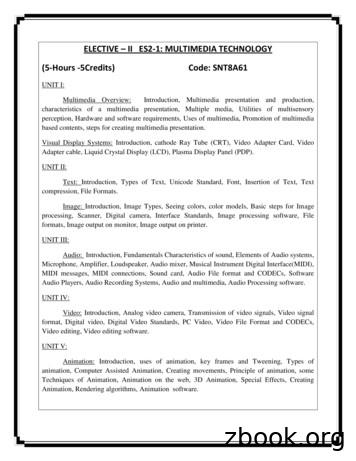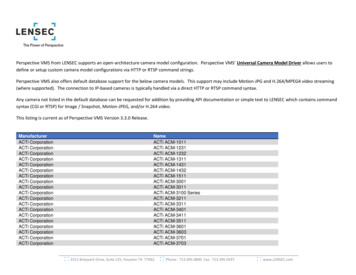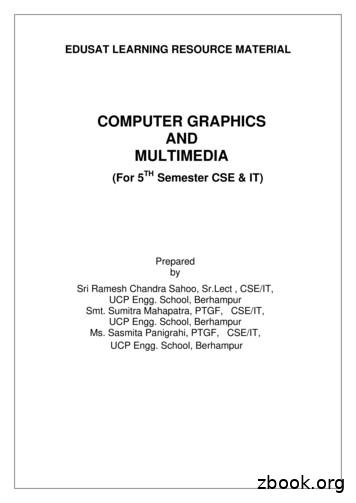Multimedia Communications Multimedia Technologies .
www.site.uottawa.ca/ elsaddikwww.el-saddik.comMultimedia CommunicationsMultimedia Technologies & ApplicationsProf. Dr. Abdulmotaleb El SaddikMultimedia Communications Research LaboratorySchool of Information Technology and EngineeringUniversity of OttawaOttawa, Ontario, Canadaelsaddik @ site.uottawa.caabed @ mcrlab.uottawa.ca1www.site.uottawa.ca/ elsaddikwww.el-saddik.comBeyond the E elsaddikOutline Quality of Media vs. Quality of Service QoS Layered Model for Multimedia Systems QoS Parameters Types of Services QoS Intervals Negotiation Bilateral peer-to-peer negotiation Triangular negotiation for information exchange IP QoS Networks Resource ReSerVation Protocol (RSVP) DiffServ Rate-Based Scheduling Disciplines2www.site.uottawa.ca/ elsaddikwww.el-saddik.comBeyond the E elsaddikQuality of Media vs. Quality of Service Quality. with respect to a Quality "Parameter"("Measure"?) Example Audio QoM (huge set exists in professionalaudio): Frequency Spectrum (linear amplification? .) Signal2Noise Ratio SNR (noise, click, .) Example Video QoM spatial / temporal resolution SNR intuitively spoken: QoM: something like "HiFi Audio" (16.20k Hz) QoS: something like "Hi bandwidth" (1Gbps) but: if application delivers HiFi Audio to the user, it does soas a "service“3Beyond the E elsaddik therefore in the remainder: QoS1
www.site.uottawa.ca/ elsaddikwww.el-saddik.comQuality of Service (QoS)ISO standard defines QoS as a concept for specifying how“good” the offered networking services are.QoS elements: How to define QoS Parameter set How to determine QoS Negotiation procedure How to ensure QoS Reflection in appropriate network access mechanisms(scheduling)QoS has different implications in different fields: 4 Beyond the E elsaddik www.site.uottawa.ca/ elsaddikwww.el-saddik.com Operating system / Resource schedulingFile system organizationCompressionCommunication system supportMedia synchronization.User InterfaceQoS Layered Model for Multimedia SystemsUser(User QoS)Application(Application QoS)Multimedia System(operating and Communication System)(System QoS)(Device QoS)MM Devices(Network QoS)Network5www.site.uottawa.ca/ elsaddikwww.el-saddik.comBeyond the E elsaddik6Beyond the E elsaddikQoS - Layer Model Perception QoS Tolerable Synchronization Drift Visual Perceptibility Application QoS parameters describe requirements for: Media quality (media characteristics, end-to-end delay) Media relations (media conversion, mediasynchronization) System QoS CPU Rate / Usage Available Memory Communication QoS Packet Size / Rate Bandwidth End-to-End-Delay Device QoS Seek / Data Transfer Rate Sample Rate / Resolution2
www.site.uottawa.ca/ elsaddikwww.el-saddik.comQoS Parameters - Example Transport System Common parameters concerning the Transport Systemare: Bandwidth /Throughput Delay (Latency) Jitter Order Loss (Reliability)DelayThroughputbut also:7www.site.uottawa.ca/ elsaddikwww.el-saddik.comBeyond the E elsaddikLoss / ReliabilitySecurity / Costs / orkInfrastructure8www.site.uottawa.ca/ elsaddikwww.el-saddik.comBeyond the E elsaddikLatency (Delay)54 3 21Time delay5 4 392 1NetworkInfrastructureBeyond the E elsaddik3
www.site.uottawa.ca/ elsaddikwww.el-saddik.comSources of DelayPropagation Delay Delay through a physical mediumLink Speed Data transfer determined by link bit rateQueuing Time spent in router queuesHop Count Each router or switch adds queuing delay10www.site.uottawa.ca/ elsaddikwww.el-saddik.comBeyond the E elsaddikJitter54 3 21time uottawa.ca/ elsaddikwww.el-saddik.comBeyond the E elsaddikOrder (Re-Sequencing)5124 3 21NetworkInfrastructureBeyond the E elsaddik4
www.site.uottawa.ca/ elsaddikwww.el-saddik.comLoss54 3 21513421NetworkInfrastructurewww.site.uottawa.ca/ elsaddikwww.el-saddik.comBeyond the E elsaddik14www.site.uottawa.ca/ elsaddikwww.el-saddik.comBeyond the E elsaddik15Beyond the E elsaddikExample QoS Parameters (cont.) Delay: Maximum end-to-end delay for transmission of onepacket Delay jitter maximum variance of transmission Throughput: Maximum long-term rate maximum amount of dataunits transmitted per time interval (e.g. packets or bytes per second) Maximum burst size Maximum packet size Loss: Sensitivity class: ignore / indicate / correct losses Loss rate maximum number of losses per timeinterval Loss size maximum number of consecutively lostpacketsQoS parameters and types of servicenote: QoS parameters often subject to statistical process mean, min, max, distribution, variance, . Guaranteed Service values or intervals of QoS parameters deterministic (at any time) statistical (consider a time interval or certainpropability) QoSmin P QoSmax Predictable Service based on past network behavior QoS parameters are estimates of past behavior consider history from the very beginning of calculation “if it was like that in the last ., you can rely on .” Best Effort Service no or just partial guarantees most of current network protocols have best effortservices5
www.site.uottawa.ca/ elsaddikwww.el-saddik.comQoS Intervals Parameter values result in acceptable regions inacceptable regions of QoS note: below required QoS level - no reasonable service above required QoS level - unnecessary resourceconsumption / costsRequired QoSDesired QoSIncreasingQoSAcceptable QoSQoS too bad16QoS too goodwww.site.uottawa.ca/ elsaddikwww.el-saddik.comBeyond the E elsaddikQoS Intervals: multidimensional intervalsFrame rateMax. QoSFrame rate3020Acceptable RegionMin. QoSFrame rate10Unacceptable Region80x4017www.site.uottawa.ca/ elsaddikwww.el-saddik.comBeyond the E elsaddik640x480Resolution(Pixel)QoS18Beyond the E elsaddik6
www.site.uottawa.ca/ elsaddikwww.el-saddik.comBilateral peer-to-peer negotiation Negotiation between two peers, with serviceprovider not allowed to modify QoS QoS valueChangedQoS valueConnectindicationConnectConnectconfirmt1 requestt4Connectt3 responset2Service Provider19www.site.uottawa.ca/ elsaddikwww.el-saddik.comBeyond the E elsaddikTriangular negotiation for information exchange caller introduces into request average value of QoS parameter value can be changed by service provider/callee at the end of negotiation, all parties have the same QoSparameter valuePeer-to-peerNegotiationCallerRequestedQoS valueConnectconfirmCalleeChangedQoS valueConnectindicationConnectt4t1 requestChangedQoS valueConnectt2t3 responseService Provider20www.site.uottawa.ca/ elsaddikwww.el-saddik.comBeyond the E elsaddikTriangular negotiation for bounded target caller specifies target QoS (average value) and lowest QoSacceptable; service provider not allowed to change the min. QoS value(connection may be rejected, however), but may change the targetvalue; callee makes the final selection of target QoS value and confirms ectedQoS valueConnectconfirm21t4t1CalleeAvailableQoS valueLowestQoS oS valueConnectt2t3 responseService ProviderBeyond the E elsaddik7
www.site.uottawa.ca/ elsaddikwww.el-saddik.com22www.site.uottawa.ca/ elsaddikwww.el-saddik.comBeyond the E elsaddikStream Protocol -2 (ST-2)Internet Stream Protocol, Version 2 (ST-2): Internet RFC 1190 (Oct.1990) “Full” protocol with data handling and controlmessages Connection-oriented substitute for IP: Multicast support Resource reservation support Main abstractions: Routing tree from one source to multipletargets Created during connection establishment Originally only sender-initiated connectionsetup “Flow Specification” describes QoSparametersIP Networks - QoS QoS is about managing congestion while making optimaluse of resources RSVP: Uses signaling and per-flow info Diffserv: differential queuing, aggregate traffic Media Scaling Bandwidth Control Congestion Control23www.site.uottawa.ca/ elsaddikwww.el-saddik.comBeyond the E elsaddikIP Networks - Integrated Services Enhance IP’s service model Old model: single best-effort service class New model: multiple service classesincluding best-effort class and QoS classes Key architecture difference Old model: stateless New model: per flow states maintained atrouters Used for admission and scheduling Setup by signaling protocol24Beyond the E elsaddik8
www.site.uottawa.ca/ elsaddikwww.el-saddik.comIP Networks - Integrated Services Each flow has a fixed path Routers along the pathmaintain the state of theflows Relies on resourcereservation25www.site.uottawa.ca/ elsaddikwww.el-saddik.comBeyond the E elsaddikIP QoS Networks - IntServ RSVP (ReSource reserVation Protocol) Path of guaranteed bandwidth Reservations on a per flow basis Resources are managed per-flow Controlled Load Service, Guaranteed Service Every forwarder examines, classifies and policesevery packet Advantage: QoS guaranteed Disadvantage: Scalability a problem26www.site.uottawa.ca/ elsaddikwww.el-saddik.comBeyond the E elsaddik27Beyond the E elsaddikResource ReSerVation Protocol (RSVP): Version 1 of RSVP has been specified in RFC 2205 Contains only protocol elements for control, not datatransfer Companion protocol to IP: Controls how IP sends a packet Resource reservation support Main abstractions: IP multicast routing tree from source(s) to multipletargets Receiver-initiated reservation Filtering provides for: Heterogeneous receivers Different reservation styles Concentrates on resource reservation only Allows aggregations using filters resource allocations for sum of sources New sender-oriented RSVP version9
www.site.uottawa.ca/ elsaddikwww.el-saddik.comRSVP Creating and maintaining reservation state: Source: Sends PATH message Receiver: Joins multicast group Determines own QoS requirements Sends RESERVATION message Periodic refresh of ‘soft state’ via transmission of PATH messages RESERVATION message Source not restricted from transmitting data at any time Packets may go across unreserved routes User data forwarding protocol has to be aware of relation between a packetand reserved resources(1) Path(2) Path(3) Path(4) Path28(10) Reswww.site.uottawa.ca/ elsaddikwww.el-saddik.comBeyond the E elsaddik(9) ResRSVP & QoSApplicationPacketClassifierwww.site.uottawa.ca/ elsaddikwww.el-saddik.com(6) ResReservation Protocol: A host uses RSVP to request a specificQuality of Service from the network.RSVPDaemonBeyond the E elsaddik(8) Res(7) ResRSVP in a host / router29(5) PathRSVP in acketSchedulerReceiver Receiver Receiver#1#2#3IP QoS Networks - DiffServ Differentiated Services (Diff-Serv) Traffic classification, policing or conditioning atborder or edge nodes Per Hop Behaviour based QoS Packets allocated a specific Class of Service(CoS) Determines relative forwarding priority ordrop sequence Different amounts of bandwidth allocated todifferent classes Advantage:- Lower router overheads Disadvantage:- QoS cannot be guaranteed30Beyond the E elsaddik10
www.site.uottawa.ca/ elsaddikwww.el-saddik.com31www.site.uottawa.ca/ elsaddikwww.el-saddik.comBeyond the E elsaddikCombining RSVP & Diffserv IntServ more suited to access network DiffServ more suited to core network Good QoS system Uses both methods IntServ confined to edge of network How it works Sender sends PATH message to diffserv networkingress router PATH is carried transparently through diffserv network Receiver responds with RESV RESV follows PATH trail back towards sender Diffserv ingress router determines whether to admitRSVP request based on mapping from requestedservice type to diffserv service level and capacity atthat service level, per SLA (Service Level Agreement)IntServ vs. DiffServIntServnetwork32www.site.uottawa.ca/ elsaddikwww.el-saddik.comBeyond the E elsaddik33Beyond the E elsaddik"Call proachQoS Translation Human Interface-Application QoS: TuningService Graphical User Interface (GUI) for user inputof desired application QoS and output ofnegotiated QoS Application QoS-System QoS translation maps application requirementsinto system QoS parameters (e.g., “highquality” lip-synchronization user requirementis mapped to few msec audio-video “skew”QoS parameters) System QoS-Network QoS maps system QoS (e.g., transport packetsend-to-end delay) into underlying networkQoS parameters (e.g, in ATM, cell end-to-enddelay) and vice versa11
www.site.uottawa.ca/ elsaddikwww.el-saddik.com34www.site.uottawa.ca/ elsaddikwww.el-saddik.comBeyond the E elsaddikMedia Scaling Scaling means sub-sampling a data stream and onlypresenting a fraction of its original contents Adjusting media stream according to networkbandwidth can be done either at the source or at the destination Two methods Transparent scaling: transport system scales-down the media, bydropping some portion of stream; must identifyportions dropped. Non-transparent scaling: requires some interaction of transport system withthe upper layers; modification of media stream before it is presentedto transport layer; typically requires modification of some parametersin the coding algorithms, or even re-coding of astream that was previously encoded in a differentformat.Scaling and reservation Relation between reservation and scaling Reservation: Available in more and more networks Should be utilized by higher layers Scalability: Complementary technique Feasible for existing networks Makes solution more stable throughdynamic adjustment Requires appropriate mediaencoding35www.site.uottawa.ca/ elsaddikwww.el-saddik.comBeyond the E elsaddikVideo Scaling Methods Multitude of scaling dimensions Temporal reduces frame rate Spatial reduces pixel number Frequency reduces number of DCT coefficients Amplitude reduces color depth for each pixel, e.g. by coarserquantization of DCT coefficients Color space number of colors, luminance/chrominance36Beyond the E elsaddik Usability of scaling dimension depends on: Coding method System support (knowledge about datastream structure)12
www.site.uottawa.ca/ elsaddikwww.el-saddik.comMultiple Target ScenarioProblem: Different throughput to different targets Different capabilities of different targetsTarget 2RouterOriginTarget 137www.site.uottawa.ca/ elsaddikwww.el-saddik.comBeyond the E elsaddikSolutions: Worst for all (“socialist approach”) Best for all (“capitalist approach”) Not all connections go to all targetsHeterogeneous Receiver- FilteringTargets require different quality levels: New compression schemes (e.g.,MPEG-2)offer hierarchical coding Data stream can be divided into sub-streams Only desired information part is forwarded Not interesting part is removed by filters (inthe network)Delivered SubstreamsS2S1S038www.site.uottawa.ca/ elsaddikwww.el-saddik.comBeyond the E elsaddikAvailable QualityQ2Q1Q0Resource Admission Service Follows QoS specification at each layer; Checks availability of shared resources, throughadmission tests schedulability test (CPU sched., packetsched. for given QoS) spatial test (buffer allocation for QoSguarantees) link bandwidth test (throughput guarantees) Based on admission tests, creates either“reserve” message with admitted QoS values or“reject” message when min. QoS cannot besatisfied.39Beyond the E elsaddik13
www.site.uottawa.ca/ elsaddikwww.el-saddik.comResource Reservation/Allocation ProtocolSenderUserReceiverEnd-SystemResource ManagerEnd-SystemResource ManagerQoS ion-reserv.requestQoS connectionacceptNetworkQoS dmission-allocat.requestQoS connectionaccepted40www.site.uottawa.ca/ elsaddikwww.el-saddik.comBeyond the E elsaddik41www.site.uottawa.ca/ elsaddikwww.el-saddik.comBeyond the E elsaddikResource Management During Multimedia Transmission Rate Control New rate-based flow control and servicedisciplines Provide with a min. service rate, independentof traffic characteristics of other connections Provide throughput, delay, jitter, and loss-rateguarantees End-to-End Error Control End-to-end data integrity Resource Monitoring Monitoring of resource utilization during MMconnection Resource Adaptation Dynamic change of QoS parametersFlow Control of Bursty Traffic End-to-end window-based, e.g., TCP Rate-based: source rate is adjusted withfeedback from the destination and thenetwork Credit-based: hop-by-hop window-based Pre-allocated buffers per connection42Beyond the E elsaddik14
www.site.uottawa.ca/ elsaddikwww.el-saddik.comEnd-to-End Window-Based “Best effort” used in TCP The size of the window determines the number ofoutstanding PDUs without positiveacknowledgement Example: for window size k, PDU withsequence number n cannot be sent before thesender receives a positive ACK for PDU n-k PDU protocol data unit43www.site.uottawa.ca/ elsaddikwww.el-saddik.comBeyond the E elsaddikEnd-to-End Window-Based in TCP“Slow start” mechanism in TCP, controls windowsize in order to avoid congestionWindow sizeCongestion (negative ACK)Slow startTime “Slow start” is in fact shaping the bursty data sources44www.site.uottawa.ca/ elsaddikwww.el-saddik.comBeyond the E elsaddikRate-Based Scheduling Disciplines Fair Queuing Virtual Clock Delay Earliest-Due-Date (Delay EDD) Jitter Earliest-Due-Date (Jitter EDD) Stop-and-Go Hierarchical Round Robin (HRR)45Beyond the E elsaddik15
www.site.uottawa.ca/ elsaddikwww.el-saddik.com46www.site.uottawa.ca/ elsaddikwww.el-saddik.comBeyond the E elsaddik47www.site.uottawa.ca/ elsaddikwww.el-saddik.comBeyond the E elsaddikFair Queueing If N channels share an output trunk, then each gets 1/N ofthe bandwidth If a channel uses less than its share, then the portionsaved is shared among the rest equally Mechanism can be achieved by Bit-by-bit Round Robbin(BR) among the channels, but is inefficient: one bit from each queue that has a packet in it Fair queueing emulates BR: each packet is given a finish number, which is theround number at which the packet would have receivedservice, should the server have used BR (finish numbercalculated given bit rate and no.of active connections) packets are served in the order of that round number(increasing) channels can be given different fractions of bandwidth,by assigning them weights, which correspond to thenumber of bits of service the channel receives perround of BR service.Weighted Fair Queuing Generalization of Fair Queueing For VC (Video conferencing) / sessions withdifferent rates One round-robbin cycle gives serviceproportional to the session rate e.g., twice the rate gets twice the number ofbits in BR Delay is inversely proportional to VC / sessionrate Currently proposed by IETF INT-SERV workinggroup for the Internet guaranteed QoS It has been proven that if traffic shaped at theend of the network with a token-leaky bucket andthen WFQ in all nodes, then end-to-end delay isboundedVirtual Clock This discipline emulates Synchronous Time DivisionMultiplexing (STDM) in an asynchronous network Each switch has a LOCAL TIMER: Virtual Clock A virtual transmission time is allocated to each packet(time stamp) time at which the packet would have been transmitted,if the server would actually be doing STDM. time-stamp equal to max of real-time and deadline Virtual Clock Time is used to determine transmission priority low rate connections have low priority Per VC /session queueing and scheduling Virtual Clock, coupled with admission control and resourcemanagement, provides deterministic bandwidth but notdelay guarantees.48Beyond the E elsaddik16
www.site.uottawa.ca/ elsaddikwww.el-saddik.com49www.site.uottawa.ca/ elsaddikwww.el-saddik.comBeyond the E elsaddik50www.site.uottawa.ca/ elsaddikwww.el-saddik.comBeyond the E elsaddikDelay Earliest-Due-Date (Delay EDD) Delay EDD is an exten
Multimedia Communications Multimedia Technologies & Applications Prof. Dr. Abdulmotaleb El Saddik Multimedia Communications Research Laboratory School of Information Technology and Engineering University of Ottawa Ottawa, Ontario, Canada elsaddik @ site.uottawa.ca abed @ mcrlab.uottawa.ca
Introduction to Multimedia (continued) Multimedia becomes interactive multimedia when a user is given the option of controlling the elements. Interactive multimedia is called hypermedia when a user is provided a structure of linked elements for navigation. Multimedia developers develop multimedia projects.
Learn the phases involved in multimedia planning, design and production; Be able to use various multimedia authoring tools Be able to design and create interactive multimedia products Develop competencies in designing and producing instruction-al multimedia Apply contemporary theories of multimedia learning to the development of multimedia .
MULTIMEDIA TECHNOLOGY UNIT – I Multimedia an overview: Introduction The word ‗multimedia‘ comes from the Latin words multus which means ‗numerous‘ and media which means ‗middle‘ or center. Multimedia therefore means ‗multiple intermediaries‘ or ‗multiple means‘. Multimedia
MULTIMEDIA V.S MULTIMEDIA INTERAKTIF Multimedia adalah penggunaan berbagai jenis media (teks, suara,grafik,animasi,danvideo). Multimedia interaktif menambahkan elemen ke-enam yaitu aspek interaktif Pada multimedia non-interaktif, user bertindak pasif dan menyaksikan adegan demi adegan secara berurut
multimedia contexts and for converting one file format to another. Multimedia Editing Tools- These tools are used for creating and editing digital multimedia data. Multimedia Authoring Tools- These tools are used for combing different kinds of media formats and deliver them as multimedia contents. Graphic and Image Editing Software
Axis Communications AXIS 215 PTZ-E Axis Communications AXIS 216FD Axis Communications AXIS 216FD-V Axis Communications AXIS 216MFD Axis Communications AXIS 216MFD-V Axis Communications AXIS 221 Axis Communications AXIS 223M Axis Communications AXIS 225FD Axi
Multimedia Systems; Buford; Pearson 3. Multimedia: Sound and Video by Jose Lozano, PHI 4. Multimedia Systems,Tech. & Communications; S.Pandey, M.Pandey; Katson. Chapter 1 Applications of Computer Graphics & Multimedia Copy Right DTE&T,Odisha Page 1 1. Applications of Computer Graphics & Multimedia
An Introduction to Literary Criticism and Theory Before we begin our examination and study of literary theory, it is important that we define exactly what literary theory is and is not, identify some of the main characteristics of such, as well as identify some of the key differences between traditional “literary criticism” and “literary theory.” While literary criticism since the late .























